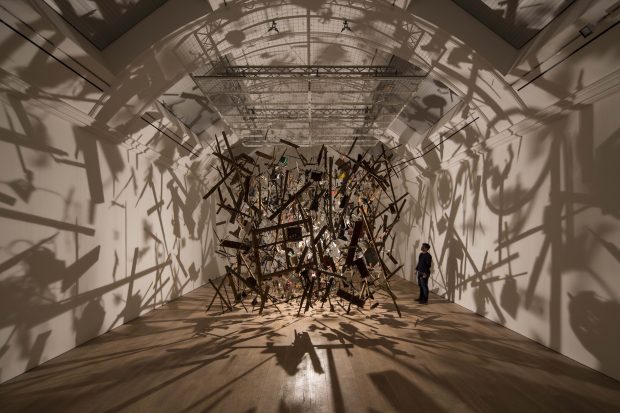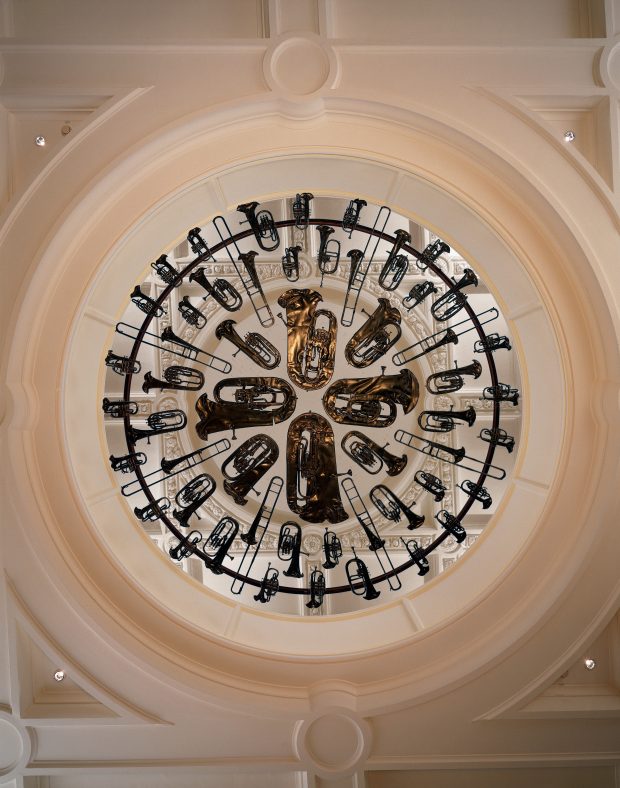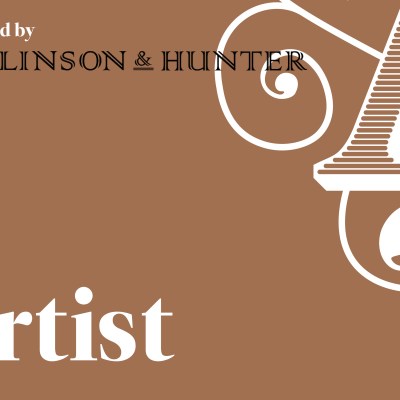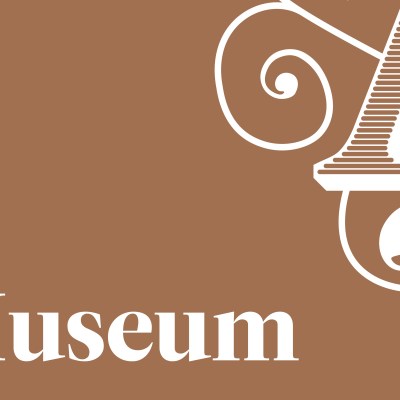Cornelia Parker
For the last six months in New York, there’s been a very different penthouse in town: a blood-red Second Empire-style mansion perched right on the edge of the roof of the Metropolitan Museum of Art. From the street, Cornelia Parker’s Transitional Object (PsychoBarn) looks like a strange and lonely gothic dolls house. Up high, looming over central park and the skyscrapers behind it, it’s a lost rural idyll in the midst of a metropolis. Wander round to the back of the house though and you realise it’s just a façade, like those on a film set. The shape-shifting continues: in window reflections it looks like a mirage; on Instagram it’s a selfie-by-sunset spectacle; at night, with only the city’s sodium haze illuminating it, the PsychoBarn is at its most sinister.
Transitional Object (Psychobarn), (2016), Cornelia Parker. Photo: Hyla Skopitz, The Photograph Studio; © The Metropolitan Museum of Art

‘It’s hard to compete with the view so I thought I wouldn’t, I’d just add something to it,’ Parker tells me about her site-specific sculpture for the Met Museum’s annual rooftop commission. Skylines have long fascinated Parker, who based one of her earliest sculptures around a souvenir model of the Empire State building. ‘With the commission, I was thinking about New York roofs – the water towers there and the propped up signs and particularly Walker Evans’s photography of them.’ It’s four days before the American election when we meet at her North London house (decidedly much cosier than her installation). She recounts the project’s detailed production: how the whole house, except for the screws, was completely fabricated from an old red barn she found in upstate New York, and which was transported to a big warehouse in Long Island. There it was transformed into a mansion styled on the Bates’ hilltop lair in Alfred Hitchcock’s Oedipal thriller Psycho (itself inspired by Edward Hopper’s melancholy 1925 painting House by the Railroad). The 25ft-high house was scaled precisely to the Met’s roof garden: ‘You can’t really see the PsychoBarn head on. It’s always seen from an angle, the way you see it in the film. And then you walk behind it, you see the conceit.’ It was built by a team of Broadway set builders and had to be tested to withstand 100 mph winds (being outside for 200 years, the barn’s framework was pretty weather-resilient).
Transitional Object (PsychoBarn) came into being against the backdrop of the election and the tumultuous campaign certainly influenced Parker: ‘Politicians on the campaign trail often stand in front of red barns. The barn represents good old-fashioned American values and a pioneering spirit. Even though the red barn and its design came over with the Europeans, it’s totally synonymous with America as a whole.’ Parker has a long history of recasting found objects, from the garden shed she exploded for Cold Dark Matter: An Exploded View (1991), to curatorial endeavours like the exhibition ‘Found’ at the Foundling Museum this year, where Parker invited over 60 artists and writers to exhibit objects that resonated with them. Among the entries, displayed around the museum and its collection of art and abandoned children’s belongings, were a whale’s tooth and John Lennon’s school detention record.
Cold Dark Matter: An Exploded View (1991). Installation view at the Whitworth Art Gallery, Manchester, 2015. Photo: David Levene

Parker treats artworks and films the same as found objects, as when she draped string over Rodin’s sculpture The Kiss, in homage to Marcel Duchamp. ‘Here the Psycho mansion and Hopper’s painting, two things which are very unheimlich, come together in this object that is very homely,’ she explains. ‘Transitional object’ is the psychoanalyst Donald Woods Winnicott’s term for the object that weans you off your mother. Parker is certain that Hitchcock, lover of psychoanalysis, would have been aware of it and points to the bunny on Norman Bates’ bed in Psycho as proof.
‘Psycho is in black and white, but don’t we always see the house as red?’ Parker suggests. That particular hue was very important to her: ‘The two sources of pigment for the red of the old barns were rust and animal blood [mixed with linseed oil]. Blood was ubiquitous for farmers. The rust resulted in a dark burnt red rather than a bright red. I like that slightly pagan feel. Now you get your “Barn Red” paint from shops.’
Parker, who grew up on a farm in Cheshire, was also influenced by Manhattan’s history and how at one point, the city was covered in red barns. But it’s hard not to read more political meaning into her sculpture. After all, Trump Tower is only a few blocks away down 5th Avenue. Parker spent Halloween in New York capturing people dressed up on the streets with her iPhone for a series of short films (for a forthcoming show at Frith Street Gallery). She also spent time filming outside Trump HQ: ‘I was waiting, hoping to get a photo of Trump with the PsychoBarn in the background. Although really, I wouldn’t want him to be associated with it.’ When we speak again a few days after the election, Parker says she now thinks of the work as a premonition. She tells me she’s devastated about the result, even more so than after Brexit, due to the threat that Trump’s presidency poses to the whole world and particularly to the environment.
‘Increasingly I’m more politically minded,’ she says. ‘But I don’t want to make polemical or narrow work. There was an American show rallying against gun violence and they wanted to exhibit my Embryo Firearms [a 1995 sculpture of two Colt 45 Guns in the earliest stage of their production]. And I said no. Not that I’m pro-gun. But I don’t want the piece to become an anti-gun piece.’ For that work, Parker collaborated with NRA-affiliated firearm factory workers. Other unusual collaborators include the British army (who helped her blow up the garden shed), HM Customs & Excise (who donated cut-up porno videotapes for her Pornographic Drawings series), and most recently, 36 prisoners who, alongside numerous public figures, embroidered for her the Wikipedia entry for Magna Carta (An Embroidery) (2015). Julian Assange and former head of MI5 Eliza Manningham-Buller stitched the word ‘freedom’; Edward Snowden stitched ‘liberty’. In a world that is becoming increasingly politically and socially polarised, Parker makes a habit of moving art and its production outside of the art-world bubble.
Breathless, (2001), Cornelia Parker. Photo: © Victoria and Albert Museum

‘The ambivalence of art is important,’ she believes. ‘That’s what I admire about Christo and Jeanne-Claude, that they wrapped up the Reichstag and then said it had nothing to do with politics. Although it obviously had. But it was also about beauty and form. That just liberated everyone. It was open for interpretation. There should always be space for the viewer. Like music has. That’s why I think Bob Dylan is getting the attention now that he deserves. Part of his power is that although people think of him as a protest singer, his protests were universal and they weren’t pegged to one political situation.’
‘Rather than hope to influence people through an artwork, I’m quite willing to be vocal about things I see being destroyed,’ she continues. One such thing is art history A-level. ‘It’s madness,’ she says of the government’s decision to axe it. ‘It helps people digest culture. If you take that away, a lot of things die. It will still be offered in private schools. But we don’t want art by the rich for the rich.’
In 1990, in one of her most delicate interventions, Exhaled Schoolhouse, Parker covered the exterior of a vacant Glaswegian school in tiny white chalk marks, drawing attention to this most ordinary of buildings by making the red bricks look like an abstract drawing. Now she worries about the dramatic cuts to arts education in the last five years, that art is not deemed useful enough, that fewer young people are encouraged or even feel able to study it, and that so many don’t have the same opportunities that she did. ‘I got six years of free grants. I was so lucky really. Having taught in art schools I’ve realised there are an awful lot of people there – or people who used to be in art schools – who weren’t academic and who would have been unemployable and would have ended up on a scrapheap otherwise, but who are functioning people because they did art. It’s really important.’
Isabel Stevens
The Apollo Artist of the Year Award is kindly supported by Rawlinson & Hunter.




